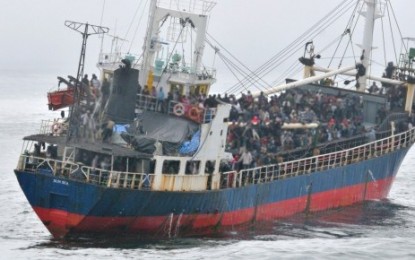Not ‘all is forgiven’ for asylum seekers returned to Sri Lanka
Niro Kandasamy, University of Melbourne
In his recent visit to Australia, the prime minister of Sri Lanka, Ranil Wickremesinghe, urged Sri Lankan asylum seekers to “come back, all is forgiven”. He went on to say: ![]()
They can come back to Sri Lanka and we will help them.
Immigration department figures show as of January 2017, there were 86 Sri Lankan adult men in detention facilities. In community detention, there are 24 adult men, 19 women, 28 boys and 15 girls from Sri Lanka.
Every one of these people are still undergoing the refugee determination process. This means there is still a risk they may be sent back to their home country if found not to be “genuine refugees”.
Explainer: how Australia decides who is a genuine refugee
Last year, the Australian government controversially sent back a boat carrying 12 Sri Lankan asylum seekers. Wickremesinghe’s reassurances echo those of Tony Abbott some years ago.
The former Abbott government consistently deemed it safe to return Sri Lankan nationals to the country, saying the civil war had ended and the country was “at peace”.
In 2014, one boat of 153 Tamil asylum seekers were intercepted at sea by Australian customs vessels and returned to Sri Lanka. Another boat carrying 28 Sri Lankan nationals were handed over to Sri Lankan authorities.
The Australian government is aware that returning people to a country where they face harm is in breach of international law and the UN Refugee Convention, to which it is a signatory.
There is mounting evidence suggesting that, during Abbott’s tenure, asylum seekers returned to Sri Lanka faced torture. There is little reason to believe much has changed since.
What’s happening in Sri Lanka?
In January 2015, Sri Lanka had a leadership change. This was generally viewed as positive for the country: a new beginning in a post-armed conflict setting.
However, things quickly turned when the new leadership showed little signs of making meaningful improvements to its transitional justice agenda. This included changing the country’s laws regarding returned asylum seekers or even considering this a priority.
When asked whether it was safe for asylum seekers to return to Sri Lanka, Wickremesinghe responded:
We just started a missing persons office. It is quite safe for them to come back.
This office was established last year to investigate the disappearance of people – mainly Tamils – during the decades of fighting between the Sri Lankan government and Liberation Tigers of Tamil Eelam (LTTE) that ended in 2009.
The outcomes of the Office of Missing Persons are questionable. There have been 20,000 cases of missing persons recorded, while not a single person listed as missing has been traced since the new government took office. Families of those missing continue to hold demonstrations to seek answers about their loved ones.
Emerging evidence challenges reconciliation efforts with the Tamil minority community and strongly argues against returning asylum seekers to Sri Lanka – in striking contrast to the views of the Australian government.
Human rights abuses
In December 2016, an official UN report on Sri Lanka showed evidence of male and female torture. This was from various periods during and after the conflict, as well as recent cases in 2015 and 2016. Medical examinations of survivors confirmed physical injuries that were consistent with their interviews.
The report highlights evidence of sexual and gender-based violence and extensive surveillance for anyone deemed to have had any links to the LTTE. It also identified the continued presence of “white van abductions”. This was a method by which gangs linked to the Sri Lankan government military abducted and silenced people suspected of opposing the dominant views of government.
The majority of white van abductions occur in Tamil-occupied areas of the north and east of Sri Lanka.
The issue of torture and other cruel, inhumane or degrading treatment of punishment is part of the legacy of the country’s armed conflict. It is one reason why Sri Lankan citizens continue to live without minimal guarantees of protection against the power of the state, in particular security forces.
They can’t go back
In 2014, the CEO of the Refugee Council of Australia, Paul Power, raised concerns about returning asylum seekers to Sri Lanka. He said the country had a “long history of political violence on a scale unimaginable to Australians”.
It is not surprising Sri Lankans fleeing persecution continue to come to Australia seven years after the war. Approximately 250,000 Tamil people fled during the final stages of the conflict in 2009.
The United Nations says around 40,000 mainly Tamil civilians were killed in this period. Those who survived became displaced in refugee camps under deteriorating humanitarian conditions. Many others risked their lives in boats, spending weeks in the ocean in search for a better life in countries such as Australia.
In its 2015 annual report, Human Rights Watch said:
The Sri Lankan government has made little progress in providing accountability for wartime abuses.
The report also identified that government obligations to address the human rights concerns of the Tamil minority population remain largely unfulfilled. And those who have returned faced indefinite imprisonment. Under these circumstances, the plight of asylum seekers returning to Sri Lanka appears to be anything but safe.
The Australian and Sri Lankan governments uphold that many asylum seekers from Sri Lanka are not fleeing persecution, and instead arrive as economic migrants.
This political rhetoric continues putting asylum seekers at risk and allows Australians to prioritise ignorance over confrontation.
Niro Kandasamy, PhD Candidate, School of Historical and Philosophical Studies, University of Melbourne
This article was originally published on The Conversation. Read the original article.

